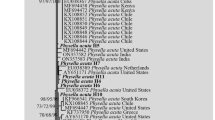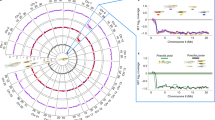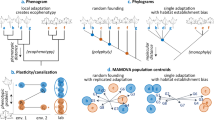Abstract
Differences in reproductive output were studied between genotypes in a population of the isopod Asellus aquaticus polymorphic at the PGI locus. Reproductive output was measured both in terms of the numbers of eggs and the number of offspring per female. Significant differences were found between the three most common genotypes (3/3, 2/3, 3/4) for both measures. 3/3 had the highest reproductive output. Relative to this the output of 2/3 was 65 per cent and of 3/4 only 40 per cent. This pattern was repeated in three separate years.
Similar content being viewed by others
Article PDF
References
Burton, R S, and Feldman, M W. 1983. Physiological effects of an allozyme polymorphism: glutamate—pyruvate transaminase and response to hyperosmotic stress in the copepod Tigriopus californiens. Biochem Genet, 21, 239–251.
Christiansen, F B, and Frydenberg, O. 1973. Selection component analysis of natural polymorphisms using population samples including mother-offspring combinations. Theor Pop Biol, 4, 425–445.
Christiansen, F B, Frydenberg, O, and Simonsen, V. 1973. Genetics of Zoarces populations IV. Selection component analysis of an esterase polymorphism using population samples including mother-offspring combinations. Hereditas, 73, 291–304.
Edwards, J P, and Heath, D J. 1983. Dynamics of an enzyme polymorphism in the isopod. Sphaeroma rugicauda (Leach). II. Sexual, gametic and fecundity selection. Heredity 51, 477–486.
Gilbert, D G, and Richmond, R L. 1982. Esterase 6 in Drosophila melanogaster: Reproductive function of active and null males at low temperature. Proc Natl Acad Sci USA, 79, 2962–2966.
Hall, J G. 1985. Temperature related kinetic differentiation of glucose phosphate isomerase alleloenzymes isolated from the blue mussel, Mytilus edulis Biochem Genet 23, 705–729.
Heath, D J, and Khazaeli, A A. 1985. Population dynamics of the estuarine isopod, Sphaeroma rugicauda. Estuarine Coastal and Shelf Sci, 20, 105–116.
Hilbish, T J, and Koehn, R K. 1985. The physiological basis of natural selection at the Lap locus. Evolution, 39, 1309–1317.
Hoffman, R J. 1981. Evolutionary genetics of Metridium senile I. Kinetic differences in phosphoglucose isomerase allozymes. Biochem Genet, 19, 145–144.
Marinkovic, D, and Ayala, F J. 1975. Fitness of allozyme variants in Drosphila pseudoobscura. II. Selection at the Est-5, Odh and Mdh-2 loci. Genet Res, 24, 137–149.
Ridley, M. 1983. The explanation of organic diversity, Clarendon Press, Oxford.
Ridley, M, and Thompson, D J. 1979. Size and mating in Asellus aquaticus (Crustacea: Isopoda). Z Tierpsychol, 51, 380–397.
Sassaman, C. 1978. Dynamics of a lactate dehydrogenase polymorphism in the woodlouse Porcellio scaber Latr: Evidence for partial assortative mating and heterosis in natural populations. Genetics, 88, 591–609.
Shihab, A. 1985. Dynamics of an enzyme polymorphism in the isopod Asellus aquaticus. Ph.D. Thesis, University of Essex.
Sokal, R R, and Rohlf, F J. 1981. Biometry, W. H. Freeman and Company, San Fransisco.
Steel, E A. 1961. Some observations on the life history of Asellus aquaticus (L) and Asellus meridianus (Racovitza). Proc Zool Soc Lond, 137, 71–87.
Verspoor, E. 1983. Allozyme frequencies in Western European populations of Asellus aquaticus (L) Isopoda and their association with water pollution. Biol J Linn Soc, 19, 275–293.
Watt, W B. 1983. Adaptation at specific loci II. Demographic and biochemical elements in the maintenance of the Colias PGI polymorphism. Genetics, 103, 691–724.
Author information
Authors and Affiliations
Rights and permissions
About this article
Cite this article
Shihab, A., Heath, D. Components of fitness and the PGI polymorphism in the freshwater isopod Asellus aquaticus (L). 1. Fecundity selection. Heredity 58, 69–73 (1987). https://doi.org/10.1038/hdy.1987.10
Received:
Issue date:
DOI: https://doi.org/10.1038/hdy.1987.10



